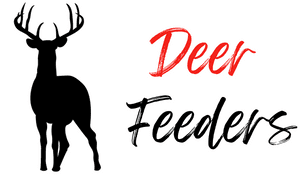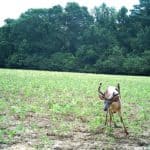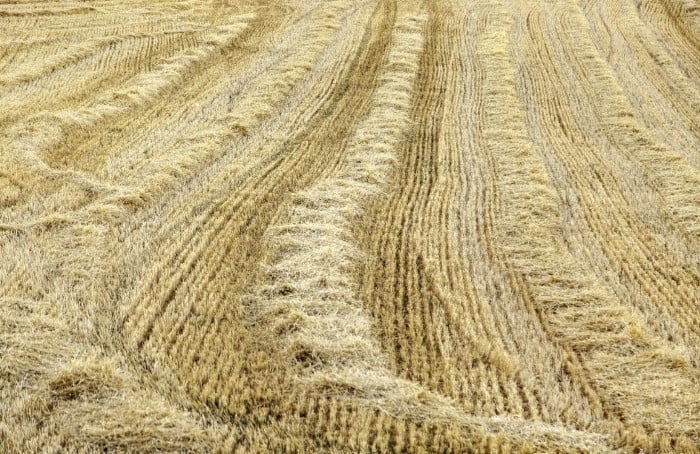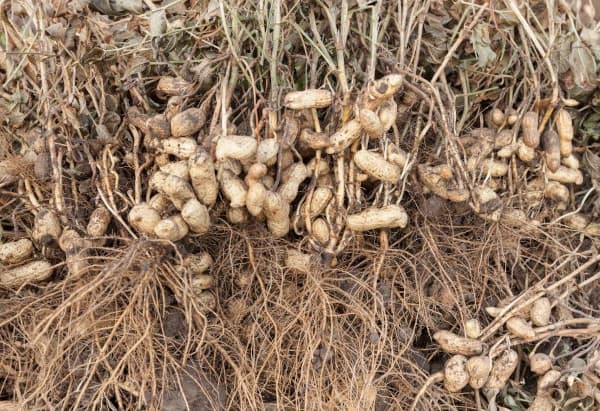If you research deer feeders or deer food plots, you’ll most likely come across information saying that food plots are better than feeders or vice-versa. There is no shortage of debates on online hunting forums about the feeder versus food plot comparison.
In my opinion, both supplemental feeding methods have their own pros and cons and have situations where one may be better than the other. So, let’s take a deeper look at the deer food plot vs deer feeder debate.
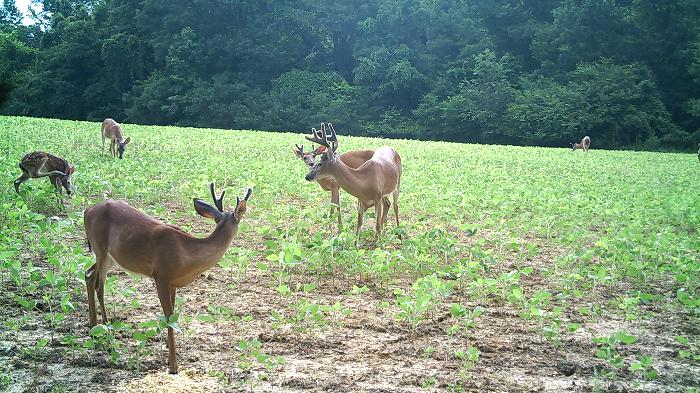
What is a Deer Food Plot?
A deer food plot is a portion of land planted with a crop or crops that are a known food source for whitetail deer (I have no experience with Mule Deer, so I can’t speak to that species). The idea behind a food plot or deer plot is to provide a source of supplemental food for whitetails that assists in the deer herd’s nutrition and growth.
While there are food plot seed options available for year-round feeding, most hunters target food plots to germinate and be accessible for food during the winter months, when the deer’s natural food sources are less available.
Food Plot Size
A deer plot (or plots) can be a large or small as a hunter wants. However, since most factors associated with a food plot (seed, fertilizer, etc.) are based on acre measurements, you may need to do some math if you opt to plant a plot less than an acre.
My first plot was 100 feet by 100 feet, and it was more of a test plot versus a serious food plot. I opted to go small as I did not have access to any farm or ATV equipment (at that time) and had to prep the plot by hand. While it was basically a flop (and I’ll get into why later), I did learn quite a bit from the experience.
Something to keep in mind, the larger the plot, the more prep work, and maintenance will be required for success.
Food Plot Seed
Since most food plots are geared towards fall and winter feeding, food plot seeds that are most popular in the south are:
- Brassica
- Oats
- Chicory
- Rye
- Winter wheat
There are many other potential food plot options, so I’d suggest doing a bit of research on what seems to be popular in your specific area.
My experience has been that rye, oat, and winter wheat were the least expensive and easiest to manage. The commercially produced deer plot seed mixtures tend to cost more and can be more challenging to manage.
Pros and cons of a Food Plot
Now that we’ve briefly discussed food plots, here are some of the positive benefits or pros that plots offer compared to feeders:
Food Plot Pros
- More Beneficial and Healthy for Deer
- Deer Seem to Spend more time at Plots compared to feeders
- Less Chance of Deer diseases
- Can offer a variety of food sources at one location
Let’s go a little bit deeper into each sub-topic:
More Beneficial and Healthy for Deer
Compared to deer feeders, food plots almost always offer food sources that are more healthy and beneficial to the deer population.
While there are several food sources that can be offered through a deer feeder, most hunters use deer corn because it’s the least expensive option, and it draws deer. Unfortunately, even though corn isn’t specifically dangerous for whitetail deer, it’s also not really a great source of nutrients either.
Most state biologists agree that between 65% and 75% of the Whitetail Deer diet consists of vegetation. Therefore, offering additional vegetation-based food sources in place of feeder corn equates to a healthier deer population.

Deer Spend More Time at Plots Compared to Feeders
While some might debate this, my overall experience has been that, in general, deer spend more time feeding at food plots compared to deer feeders. I base this opinion on camera footage as well as time spent in stands over both plots and feeders.
The one exception to that rule is scenarios where the deer plot is set up too far away from cover or does not have any nearby cover. For example, plots out in the middle of a field or plots with no edge cover usually see far fewer deer than plots with border cover.
Most deer are never far from cover and will start out feeding in the very edges of a food plot. Only when the edge food is gone will they start to venture out deeper into the plot.
Less Chance of Deer Diseases
Most food plots will offer less confined space for deer to feed in comparison to a feeder. Since the feeder only dispenses feed in a small area, the deer end up having to assemble closer together to feed.
Since the food is spaced out over a wider area with a deer plot, the deer have more room to spread out while they feed. This additional distance apart can reduce (or at least cut down) on chances for disease to spread.
Since I have the opportunity to talk to quite a few hunters at my day job, I’ve heard of far more cases of Chronic Wasting Disease (CWD) or Epizootic Hemorrhagic Disease (EHD) from hunters in my area who use deer feeders than ones who reply on food plots for supplemental feeding. But, of course, that’s not a scientific approach, so that’s not to say that deer couldn’t or won’t catch either disease (or some other disease) at a food plot as well.
Can Offer a Variety of Food Sources at One Location
Another advantage that plots offer over feeders is the ability to offer a variety of different deer food sources at one location. Most deer feeders are loaded with a single food source of feed, although you can do blends of feed as well), while plots offer the ability to plant several different food sources in one plot location. With a deer feeder, you can change the feed from one style to the next, but it requires some work to do so.
For example, a plot can be divided into quarters, with each quarter being planted with a different species of winter food. Also, the crops grown can have various germination times, which can offer food sources for a longer duration of time.
In that respect, plots offer more options for food diversity compared to a deer feeder.
Less Food Competition from Pests
There will be competition for the corn (or feed) with a deer feeder from pests like bears, squirrels, and raccoons. With those pests, the will be two potential issues:
- They will compete with the deer to consume the feed or corn from the feeder.
- Those pests can damage the feeder in an attempt to gain access to more food.
While bears are the largest pests that typically visit a feeder to eat, I find that squirrels are the more significant issue for me. They will visit a deer feeder several times a day and each as much corn or feed as possible. In addition, they will damage a feeder by chewing on it to access more feed.
You won’t have those competition issues with a food plot. About the only pests that you’ll see with a food plot are rabbits or groundhogs.
Food Plot Cons
While there are some great reasons to consider a food plot over a feeder, there are also some downsides that come with deer plots as well. Those downsides include the following:
- Success can depend on external variables like weather, rain, and soil quality (H4)
- Almost always requires food plot equipment to set up (H4)
- Harder to set up compared to a feeder but easier to manage once established (H4)
- Can be more costly than expected
Here’s a deeper look at each downside and the problems associated with it.
Success can Depend on External Variables Like Weather, Rain, and Soil Quality
With a feeder, you have a certain amount of control over the variables to make the feeder a success. For example, you control the type of feed used, the frequency that the feeder runs, etc.
However, with a food plot, there are other variables that will play a role in the success of the plot, and here’s a quick look at a few of the main variables:
- Weather
- Rain
- Soil Quality
Sometimes, these are variables or factors that hunters don’t take into consideration with a plot, and they can have a considerable impact on the success or failure of a plot crop.
Let’s look at each factor individually:
Weather
Weather conditions play a massive role in the successful germination and growth of a crop plot. Conditions like excessively hot or cold temperatures, an early freeze, flooding, and strong winds can adversely impact a crop, especially during the early germination phase, and significantly reduce the success. Obviously, you can’t control those factors, and they are a known risk.
Rain
Every food plot will require a certain amount of water to germinate, grow, and thrive, and the primary source of water is usually rainfall.
The most significant plot water-related issue I’ve encountered with rain is drought. If the crop doesn’t receive enough water (either through rainfall or through supplemental watering), the plot may not produce its max potential. Thus, a drought period can severely impact the plot’s success, especially as the seeds are beginning to germinate.
If you do experience a drought, about the only solution is to provide supplemental water. Just like you might water your lawn during a drought, the approach goes for a food plot (if you are so inclined).
Depending on the location of the plot and its accessibility, supplemental watering can range in difficulty from not too hard to absolutely impossible. In addition, due to challenges like accessibility, supplemental watering can be surprisingly expensive.
Soil Quality
Of all the potential variables that can screw up a food plot, this is the one that is preventable by having the soil tested before planting.
Having the soil tested will provide essential data on the soil Ph and provide guidelines for potential actions such as fertilization, lime, and nutrient level.
Part of the reason my first attempt at a food plot was a failure was tied to the soil. I failed to have a soil sample evaluated (lack of knowledge on my part at that time), and only about 10% of the crop germinated.
I had a soil sample done before the following season and discovered the following:
- The Ph was too high
- A supplemental fertilizer and lime application was needed
My second food plot wasn’t perfect but was significantly more successful than my first plot.

Almost Always Requires Food Plot Equipment to Set up
While you can set up a small food plot by hand (as in without any farming equipment), it’s a very labor-intensive process.
For example, my first deer plot was only 100 feet by 100 feet, but it took me several weekends of work to prep and plant without farm equipment.
Most any plot that is larger than ¼ an acre will require some kind of farming implement to complete. Those implements can either be attached to a garden tractor, farm tractor, or ATV/UTV.
Because of the popularity of all-terrain vehicles, ATV-based farming attachments have become extremely popular for use with food plots.
In addition to farming equipment, you may also need other equipment like a backpack sprayer, weeding implement, or seed dispenser.
Harder to Set up Compared to a Feeder but Easier to Manage Once Established
This is both a bit of a pro and a con, so I’ve tried to be clear on both the good and bad.
Deer food plots are much harder to prep and set up (even with farm equipment) compared to deer feeders. However, once the crop has successfully germinated, it becomes easier to manage than a feeder (at least in my opinion).
Once the crop germinates and the weather starts to cool down, barring a drought, food plots are relatively easy to manage. All the real work occurs during the soil prep, planting, and germination phases.
With deer feeders, you have the easier set-up, but you have the constant trips to refill and maintain the feeder.
Can be More Costly Than Expected
If you do any research online about the costs associated with a food plot, you’ll typically see suggestions that food plots are much cheaper to use compared to a deer feeder. You’ll also see data reporting that the total costs of a food plot costs are anywhere from .03 cents to .08 cents per acre.
While this information is probably correct, it does not consider the costs of the farm equipment or ATV implements needed to set up a food plot. The .03 to .08 cents per acre figure works if you already own or have access to the farming equipment.
When you factor in potential costs such as:
- Soil sample testing (which is cheap)
- Seed costs (can range from inexpensive up to costly for commercially made deer blends)
- Lime/fertilizer (if needed)
- Farming equipment (either buying, leasing, or hiring out)
- Weed control
- Supplemental water (if needed)
The actual costs of a food plot are significantly more than the few cents per acre that are commonly advertised.
If you’re thinking about setting up your first food plot, it’s crucial to have a realistic approximation of the true costs. Granted, if you have access to farming or ATV-based equipment, then the costs do go down substantially.
So Which is Better, Food Plot or Deer Feeder?
If you remove costs and equipment from the equation, I’ll always recommend a food plot over a deer feeder for all the reasons that I noted above.
However, with all the variables noted, I’d suggest the following:
- If you want the best of both worlds, then set up both on a property. I generally recommend a 1:1 ratio, so one feeder for each food plot.
- If you don’t have access to the necessary equipment for a food plot, then deer feeders are going to be your better option.
- If you are strictly making the decision off a budget, but have access to farm equipment, then food plots will be your cheapest option. If you don’t have access to equipment, then the deer feeders will be the less expensive approach.
- If you want the healthiest deer herd you can manage, the food plots are better.
FAQS
Here are some frequently asked questions associated with the deer feeder versus food plot debate:
How big should a deer food plot be?
If you post this question in most online hunting forums, you’re going to see various answers, ranging from a 1-acre minimum up to a 10-acre minimum.
The honest answer is as large or small as you want. However, there are a few things to be aware of with smaller plots:
- It’s important to understand that really small plots (say under ½ an acre) will only produce a certain amount of food. Depending on the feeding volume, it may not offer a food source for the entire hunting season or even the winter months.
- To a point, larger food plots are not all that much more work or management intensive compared to a smaller plot. So, for example, a 2-acre food plot isn’t really all that much more work to prep and manage than a 1-acre plot. So even though you have doubled the plot size, you haven’t doubled the workload. However, in my opinion, the prep and management efforts really begin to increase significantly with food plots that are 5 acres and up.
With smaller plots, I usually shoot for at a minimum plot size of 1 acre, although I’ve planted several plots that were well under an acre as well.
I’ve got customers at my day job, who won’t consider a food plot under 5 acres, so the answer really depends on your personal preferences and how the plot is being utilized.
How much fertilizer for deer food plots?
The accurate answer to this question is directly tied to soil sample testing. Without soil tests, you’re just making an educated guess about the amount of fertilizer needed.
With a soil sample, you can do a little math and have a much more accurate answer to the question.
This is one of the reasons that I almost always suggest a soil test before you even start prepping the plot area.
Are deer food plots worth it?
While food plots require some prep work and ongoing management, I definitely feel that they are worth it, especially if you are chasing mature bucks. With food plots, hunters usually see more deer throughout the season, have a healthier deer population, and increase the chances of seeing larger, mature bucks.
Hopefully you found this food plot information helpful, and I’ll try to keep the information up to date.
